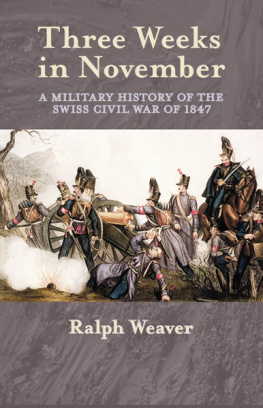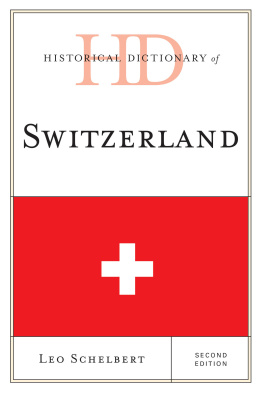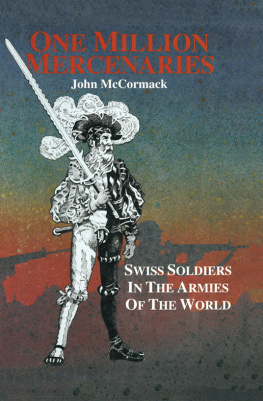
Helion & Company Limited
26 Willow Road
Solihull
West Midlands
B91 1UE
England
Tel. 0121 705 3393
Fax 0121 711 4075
Email:
Website: www.helion.co.uk
Published by Helion & Company 2012
Designed and typeset by Farr out Publications, Wokingham, Berkshire
Cover designed by Farr out Publications, Wokingham, Berkshire
Printed by Gutenberg Press Limited, Tarxien, Malta
Text Ralph Weaver 2012
Images and maps as individually credited
ISBN 978-1-908916-57-0
EPUB ISBN: 9781909384835
British Library Cataloguing-in-Publication Data.
A catalogue record for this book is available from the British Library.
All rights reserved. No part of this publication may be reproduced, stored in a
retrieval system, or transmitted, in any form, or by any means, electronic, mechanical,
photocopying, recording or otherwise, without the express written consent of Helion &
Company Limited.
Dustjacket illustrations: Front cover - Rusts Battery of the Confederate army at the Battle
of Gisikon, watercolour by Albert von Escher (Authors collection); rear cover - Combat
near a redoubt at the Battle of Gisikon (Steinhuslin, Bilder aus dem Sonderbundskriege
im November 1847, 1848).
For details of other military history titles published by Helion & Company Limited
contact the above address, or visit our website: http://www.helion.co.uk.
We always welcome receiving book proposals from prospective authors.
List of Illustrations
Images in colour section
List of Maps
Black and white in book:
In colour section:
Introduction
T his book covers a conflict little known in the English-speaking world, the civil war in Switzerland, which lasted for just three weeks in November 1847. Indeed, it is hardly mentioned in many Swiss histories, sometimes meriting only a paragraph or two. The build up to the outbreak of military action had begun much earlier, as a result of the French Revolution, which had spilled over into the Alpine towns, forests and meadows. It really was an age-old question, who are the rulers and who the ruled? The old aristocracy did not let go without a fight, at first diplomatically and finally by force of arms. It seems strange to talk about aristocrats in a land made up of republics, but the old ruling families were long-lived, generation after generation providing the rulers of many of the Swiss cantons.
The following text uses the German names of the cantons for consistency, but where some are better known to English speakers by their French names I have used that name.
German | French |
Uri | Uri |
Schwyz | Schwyz |
Nidwalden | Nidwald |
Obwalden | Obwald |
Luzern | Lucerne |
Zurich | Zurich |
Glarus | Glaris |
Zug | Zoug |
Bern | Berne |
Freiburg | Fribourg |
Solothurn | Soleure |
Basel Stadt | Bale-Ville |
Basel Land | Bale-Campagne |
Schaffhausen | Schaffhouse |
Appenzell | Appenzell |
St Gallen | Saint-Gall |
Graubunden | Grisons |
Aargau | Argovie |
Thurgau | Thurgovie |
Tessin | Ticino (in Italian) |
Waadt | Vaud |
Wallis | Valais |
Neuenburg | Neuchatel |
Genf | Geneva |
The canton name was often taken from the chief town, which name was sometimes given to one of the many lakes within the Alpine region. Thus the city of Luzern, the capital of canton Luzern, stood on the east bank of Lake Luzern. In canton Zurich, likewise, the town of Zurich stood at the head of the Lake of Zurich, similarly with Zug.
As the scene for a military campaign, Switzerland was most unsuitable, high mountain ridges separated by many rivers and lakes filling the depressions left over from the last ice age. The main roads followed the river valleys, twisting back and forth through the natural features and climbing over mountain passes where there was no other route. The time taken to travel between locations could not be measured in distance as the crow flies, but by the time taken to negotiate the route. In the history of Switzerland invaders had found to their cost that many roads concealed ambushes and that the defenders of their mountain homes could come and slip away without being seen.
The languages used by the Swiss were, and still are, German, French, Italian and a local tongue, a dialect of German. In the list of references at the end of this work most early sources are in German with some published in both German and French versions. Modern works tend to have bilingual texts. Surprisingly, some good, almost contemporary, English accounts of the war appear not in works of history, but in pocket books intended for English tourists. As with most history it tends to be written by the victors, with obvious bias towards the Confederate point of view. English texts also favour the Confederates as they were seen to be espousing a more liberal viewpoint which would appeal to the travelling English public. Conversely, books written by former Sonderbund officers and politicians (often the same people) would try to justify their own position. Language could be an issue among the Swiss, General Dufour was a native French speaker from Geneva, who led an army speaking French, German and Italian.
I have shown, in the various orders of battle, numbers of men in each company, battalion, brigade and division. Sometimes the figures do not appear to add up, or contradict another list; this is because the sources do not agree and themselves show contradictions and inconsistencies. Overall they do give a fairly good picture of the numbers of troops raised by each side in the conflict, and even though the actual fighting did not last long, original musters were only good for the day they were taken. A good example of a reason for the discrepancies in numbers is in the casualty roll. The small numbers of killed and wounded of the Sonderbund armies were gathered by the commanding officer of the Confederation army, General Dufour, and published in the official records. They were possibly kept deliberately low to minimise any animosity and to smooth the process of reconciliation. Other sources (a history of the Luzern forces) give a much higher number of Sonderbund casualties. Some of the men included in the casualty lists did not die on the battlefield, but succumbed later to their wounds, either in a hospital, or back in their home village. There was also a problem with keeping records of Landsturm (Home Guard) companies whose organisation was less rigid than the regular units.
The two sides of the conflict were: firstly, the group of cantons who set up their own separate military alliance, the German word being Sonderbund; secondly, the majority of cantons who were part of the original Confederation founded in 1815. I have tried to avoid using the term Federal for this group, as strictly speaking, the Federal Swiss state only emerged in 1848. However, the Swiss themselves used this term for several official positions, such as the officers of the regular army the small group of full time officers who were the General Staff and were styled Federal Colonel etc.
Next page










